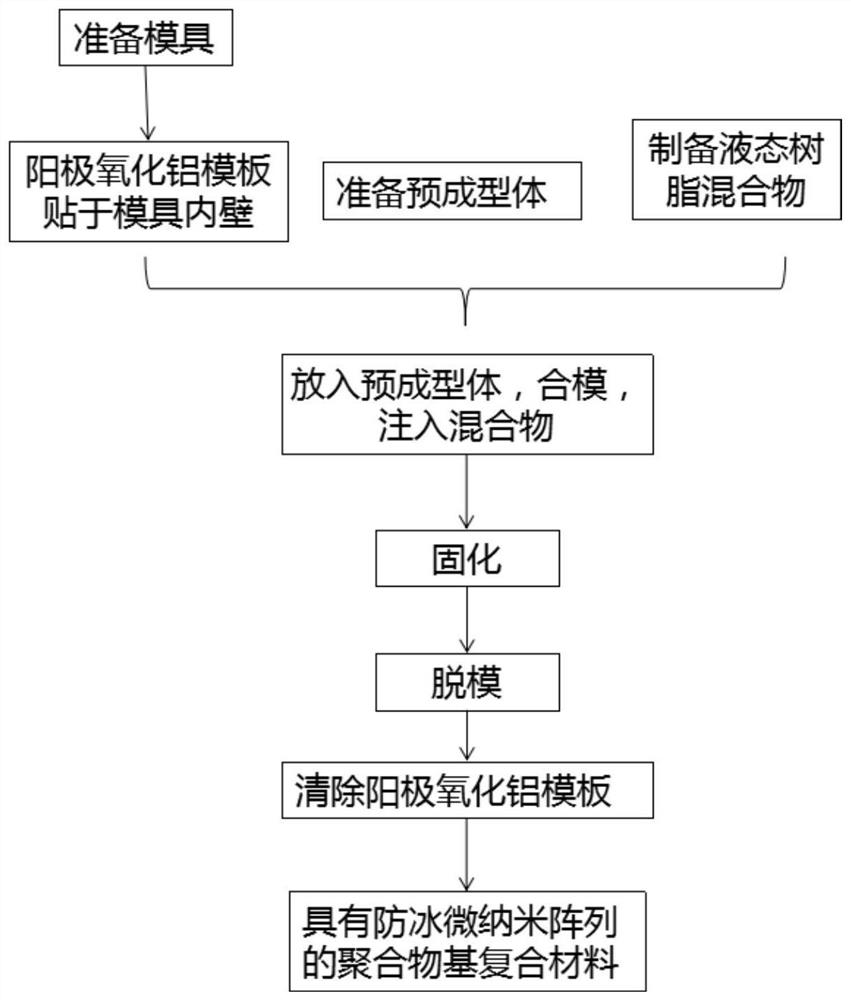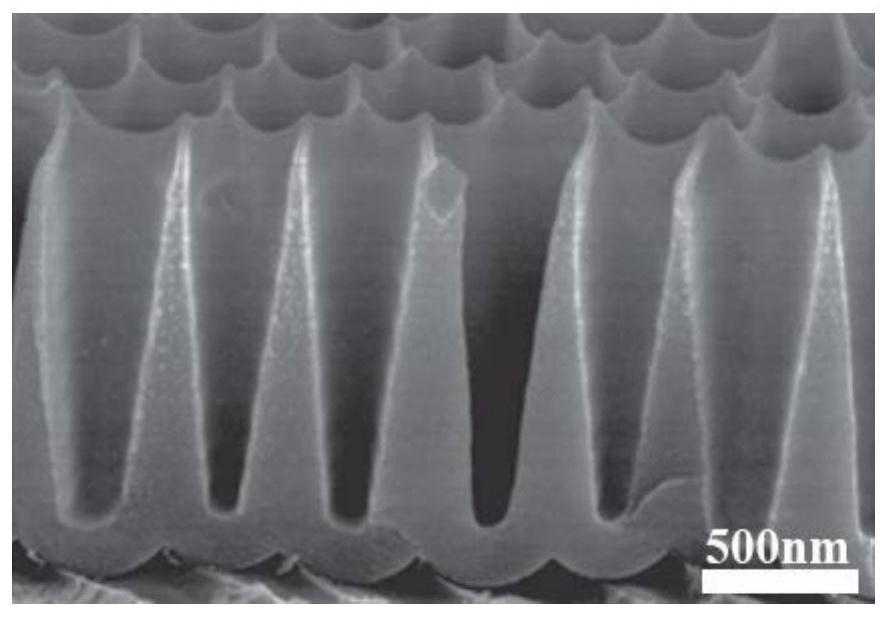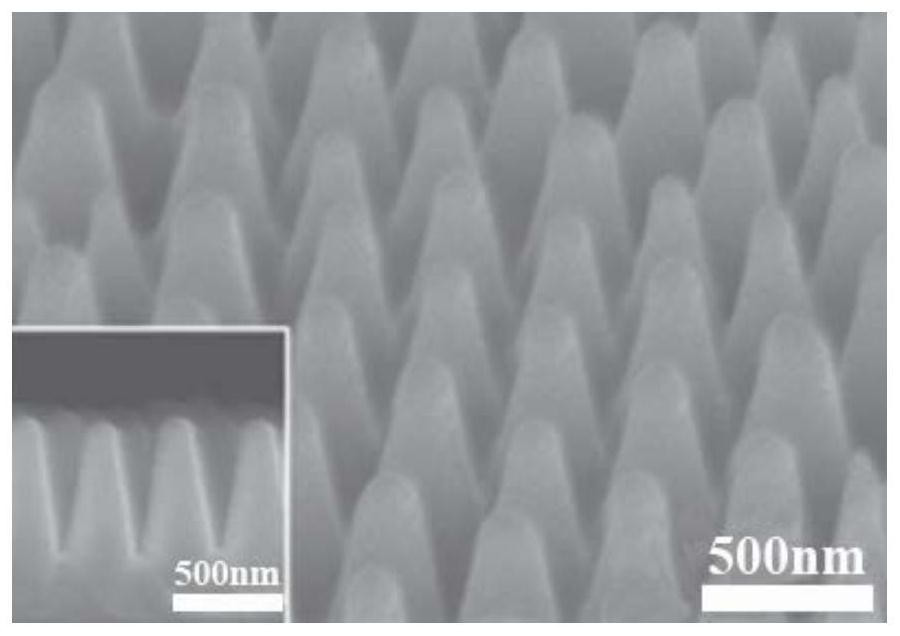Forming method of anti-icing array structure on surface of thermosetting resin-based composite material
A composite material and array structure technology, applied in the direction of climate sustainability, sustainable manufacturing/processing, household components, etc., can solve the problems of incomplete microstructure, complicated steps, difficult demoulding, etc., and achieve high structural consistency, Good superhydrophobic properties, the effect of complete microstructure
- Summary
- Abstract
- Description
- Claims
- Application Information
AI Technical Summary
Problems solved by technology
Method used
Image
Examples
Embodiment 1
[0039] refer to figure 1 , a method for forming an anti-icing array structure on a surface of a thermosetting resin-based composite material, comprising the following steps:
[0040](1) Prepare a transparent acrylic mold with an inner cavity size of 25×25×5mm, and a preform (H100 foam core material), clean and set aside.
[0041] (2) Prepare a 5×5×0.1mm anodized aluminum template with an inverted cone-shaped pit micro / nano array structure (for the structure, see figure 2 ), after cleaning, attach 70 pieces of anodized aluminum templates to the parts that need to build micro-nano structures in all the inner cavities of the mold.
[0042] (3) Place the H100 foam core material in a suitable position in the mold, and close the mold to form a closed mold.
[0043] (4) Mix bisphenol A epoxy resin LT5082, Cycracure UVI 6976 curing agent and low surface energy modifier FAS-17 in a ratio of 3:1:0.01 to obtain a liquid thermosetting resin mixture.
[0044] (5) Pour the mixed liquid ...
Embodiment 2
[0048] refer to figure 1 , a method for forming an anti-icing array structure on a surface of a thermosetting resin-based composite material, comprising the following steps:
[0049] (1) Prepare a cold-work steel mold with an inner cavity size of 70×70×10 mm, and clean it for later use.
[0050] (2) Prepare a 10×10×0.1mm anodized aluminum template with stepped pit micro / nano array structure (see Figure 4 ), after cleaning, stick 126 pieces of anodized aluminum templates on the parts that need to build micro-nano structures in all the inner cavities of the mold.
[0051] (3) Select SW220 high-strength glass fiber as the fiber cloth, cut the fiber cloth to a shape of 50×50×4mm, and wrap the H100 foam core material.
[0052] (4) Mix resin, curing agent and low surface energy modifier FAS-17 in a ratio of 3:1:0.01 to obtain a liquid thermosetting resin mixture.
[0053] (5) Place the preform wrapped in fiber cloth in a closed mold, and inject the mixed liquid thermosetting res...
Embodiment 3
[0059] refer to figure 1 , a method for forming an anti-icing array structure on a surface of a thermosetting resin-based composite material, comprising the following steps:
[0060] (1) Prepare a 304 stainless steel mold with an inner cavity size of 70×70×10 mm, and clean it for later use.
[0061] (2) Prepare a 10×10×0.1mm anodized aluminum template with an inverted cone-shaped pit micro / nano array structure, and after cleaning, attach 126 pieces of anodized aluminum template to all the inner cavities of the mold that need to build a micro-nano structure parts, to obtain a closed mold.
[0062] (3) Select SW220 high-strength glass fiber as the fiber cloth, cut the fiber cloth to a shape of 50×50×4mm, and wrap the H100 foam core material.
[0063] (4) Mix resin, curing agent and low surface energy modifier FAS-17 in a ratio of 3:1:0.03 to obtain a liquid thermosetting resin mixture.
[0064] (5) Place the preform wrapped in fiber cloth in a closed mold, and inject the mixe...
PUM
| Property | Measurement | Unit |
|---|---|---|
| diameter | aaaaa | aaaaa |
| ice adhesion strength | aaaaa | aaaaa |
| diameter | aaaaa | aaaaa |
Abstract
Description
Claims
Application Information
 Login to View More
Login to View More - R&D
- Intellectual Property
- Life Sciences
- Materials
- Tech Scout
- Unparalleled Data Quality
- Higher Quality Content
- 60% Fewer Hallucinations
Browse by: Latest US Patents, China's latest patents, Technical Efficacy Thesaurus, Application Domain, Technology Topic, Popular Technical Reports.
© 2025 PatSnap. All rights reserved.Legal|Privacy policy|Modern Slavery Act Transparency Statement|Sitemap|About US| Contact US: help@patsnap.com



